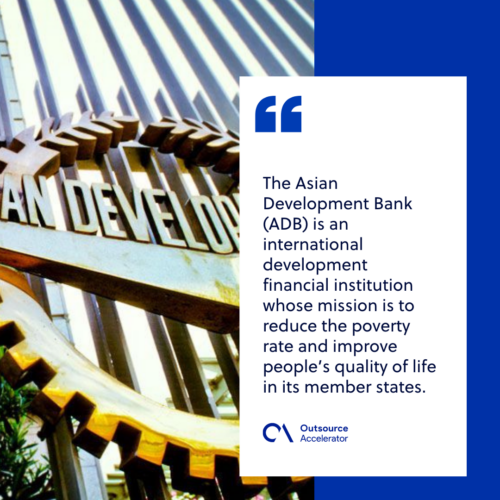Asian Development Bank (ADB)
Definition
What is the Asian Development Bank?
The Asian Development Bank (ADB) is an international development financial institution whose mission is to reduce the poverty rate and improve people’s quality of life in its member states.
The Bank partners with government and non-government organizations, private sectors, community organizations, foundations, and development agencies to pursue its institutional mission.
The ADB was founded in 1996 and is headquartered in Manila, Philippines. Its 68 member countries – of which 49 are in the Asia-Pacific region – own and finance the institution.
On June 23, 2020, the ADB officially joined the Central Banks and Supervisors Network for Greening the Financial System (NGFS) – a group contributing to developing an environment and climate risk management in the financial sector – as an observer.

What does the ADB do?
The ADB promotes development through technical assistance, loans, grants, and equity investments. It also oversees policy dialogues and offers advisory services.
With over 10,000 recorded projects since 1967, the ADB is still actively pursuing its vision of a “prosperous, inclusive, resilient, and sustainable Asia and the Pacific.”
The ADB follows a long-term strategic framework – Strategy 2020 – adopted in 2008. Under this strategy, the three complementary strategic agendas would guide the Bank: environmentally sustainable growth, regional integration, and inclusive growth.
However, rapid changes in the Asia-Pacific region necessitated adopting a better strategy for the ADB. In July 2018, the Bank adopted Strategy 2030, a more inclusive development strategy.
The ADB’s most recent initiatives include giving financial support to its developing member countries. Since early 2020, the Bank has pledged over USD 17.5 billion to help combat the effects of the 2020 crises and contribute to vaccination efforts.
The banking institution has also provided funding for the procurement, logistics, and distribution of vaccines through a USD 9 billion Asia Pacific Vaccine Access Facility.

Who can become members of the ADB?
The ADB initially only had 31 members when it was first established. Since then, the Bank has grown and currently has 49 regional and 19 non-regional members.
Any member or associate member of the United Nations Economic Commission for Asia and the Far East can apply for ADB membership. Membership is also open to other countries within the region or any developed non-regional country members of the United Nations or its specialized agencies.
ADB structure
The Articles of Agreement Establishing the Asian Development Bank–more commonly referred to as the ADB Charter – established the organizational structure of the Bank.
The charter delegated the institution’s powers to the ADB’s Board of Governors, its highest policy-making body. In turn, the Board of Governors conferred some of its authority to the Board of Directors.
One representative from each member country makes up the ADB’s Board of Governors. This legislative body meets formally during the ADB’s Annual Meeting. The Board of Governors is also responsible for electing the members of the Board of Directors and the Bank’s president.
The Board of Directors comprises 12 members, with eight chosen from member countries within Asia and the Pacific and the remaining four from member countries outside the region. The ADB’s President chairs this board.







 Independent
Independent




